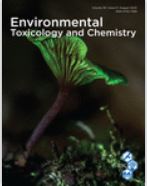A generalized bioavailability model (gBAM) for predicting chronic copper toxicity to freshwater fish

Scientific abstract
The generalized bioavailability model (gBAM) has been proposed as an alternative to the biotic ligand model (BLM) for modeling bioavailability and chronic toxicity of copper. The gBAM combines a log‐linear effect of pH on free Cu2+ ion toxicity with BLM‐type parameters for describing the protective effects of major cations (Ca2+, Mg2+ , and Na+). In the present study, a WHAM VII‐based gBAM for fish has been parametrized based on an existing chronic (30d‐mortality) dataset of juvenile rainbow trout (Oncorhynchus mykiss). The model, with the following parameters SpH=0.4449, log KCaBL=4.0, log KMgBL=3.4 and log KNaBL=3.0, was shown to accurately predict the effects of pH, DOC, Ca, and Mg on chronic Cu toxicity to juvenile rainbow trout at the effect levels relevant for environmental risk assessment (i.e. median prediction error of 1.3‐fold for 10% and 20% lethal concentrations). The gBAM predicted the effect of pH more accurately than a previously published Cu BLM for juvenile rainbow trout, especially at pH>8. We also evaluated the cross‐species and cross‐life‐stage applicability of the newly developed juvenile rainbow trout gBAM using existing chronic Cu toxicity data with early life‐stages of fathead minnow (Pimephales promelas) and rainbow trout. We did this because using a single bioavailability model for all fish species and life‐stages is practical from a regulatory point of view. Although the early life‐stage datasets exhibit considerable uncertainties, 91% of the considered toxicity values at the effect levels most relevant in European environmental regulations (10% effect on survival or growth) were predicted within 2‐fold error. Overall, the chronic Cu gBAM developed here is a valuable alternative for the existing chronic Cu BLM for rainbow trout and performs sufficiently well to be used in risk assessment according to currently accepted standards of bioavailability model performance (from the current European regulatory point of view). Yet, our analysis also suggests that bioavailability relations differ between different fish life‐stages and between endpoints (e.g. mortality vs. growth), which is currently not accounted for in environmental risk assessments.
Full reference (link):
Nys, C., Vlaeminck, K., Van Sprang, P., & De Schamphelaere, K. (2020). A generalized bioavailability model (gBAM) for predicting chronic copper toxicity to freshwater fish. Environmental Toxicology and Chemistry. https://doi.org/10.1002/etc.4806
